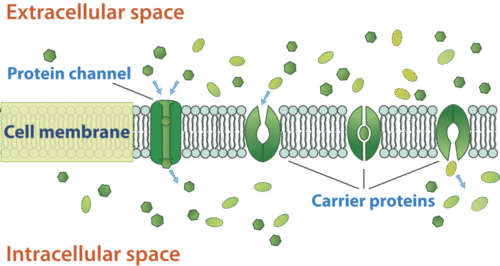4.28 促进传播 -- -- 高级
章节大纲
-
Can you help me move?
::你能帮我搬家吗?What is one of the questions no one likes to be asked? Sometimes the needs help moving things as well, or facilitating the process. And this would be the job of a special type of .
::没有人喜欢被问到的问题是什么?有时,需要也有助于推动事物的移动,或促进这一过程。这将是一种特殊的工作。Facilitated Diffusion
::推动传播Facilitated diffusion is the diffusion of solutes through integral membrane transport proteins . Facilitated diffusion is a type of passive transport . Even though facilitated diffusion involves transport proteins (and is essentially a transport process), it can still be considered passive transport because the solute is moving down the concentration gradient , and no input of energy is required. Facilitated diffusion utilizes proteins known as uniporters. A uniporter can be either a channel protein or a carrier protein .
::便利传播是溶液通过集成膜传输蛋白传播,便利传播是一种被动迁移,尽管便利传播涉及迁移蛋白(而且基本上是一种迁移过程),但仍可被视为被动传播,因为溶液正在降低浓度梯度,不需要投入能量。促进传播利用称为单质传导的蛋白。单质可以是导道蛋白,也可以是载体蛋白。As was mentioned earlier, small nonpolar molecules can easily diffuse across the . However, due to the hydrophobic nature of the phospholipids that make up cell membranes, polar molecules and ions cannot do so. Instead, they diffuse across the membrane through transport proteins. A transport protein completely spans the membrane, and allows certain molecules or ions to diffuse across the membrane. Channel proteins, gated channel proteins , and carrier proteins are three types of transport proteins that are involved in facilitated diffusion.
::如前所述,小型非极分子可以很容易地扩散到全身,但是,由于构成细胞膜、极分子和离子的磷素的疏水性,它们无法做到。相反,它们通过迁移蛋白散布在膜上,一种迁移蛋白完全跨越膜,使某些分子或离子能够扩散到膜上。渠道蛋白、闭门通道蛋白和载体蛋白是参与促进扩散的三种运输蛋白。A channel protein , a type of transport protein, acts like a pore in the membrane that lets molecules or small ions through quickly. Water channel proteins allow water to diffuse across the membrane at a very fast rate. Ion channel proteins allow ions to diffuse across the membrane.
::一种渠道蛋白,一种运输的蛋白,就像在膜中穿透孔孔,让分子或小离子快速穿透。水渠道蛋白允许水以非常快的速度穿过膜扩散。电渠道蛋白允许离子穿过膜扩散。A gated channel protein is a transport protein that opens a "gate," allowing a molecule to pass through the membrane. Gated channels have a binding site that is specific for a given molecule or ion. A stimulus causes the "gate" to open or shut. The stimulus may be chemical or electrical signals, temperature, or mechanical force, depending on the type of gated channel. For example, the sodium gated channels of a nerve cell are stimulated by a chemical signal which causes them to open and allow sodium ions into the cell. Glucose molecules are too big to diffuse through the plasma membrane easily, so they are moved across the membrane through gated channels. In this way glucose diffuses very quickly across a cell membrane, which is important because many cells depend on glucose for energy.
::闭门通道蛋白是一种可打开“ 门” 的传输蛋白, 允许分子通过膜膜。 闭门通道有一个特定分子或离子专用的绑定点。 刺激导致“ 门” 打开或关闭。 刺激可能是化学或电子信号、 温度或机械力量, 取决于闭门通道的类型。 例如, 神经细胞的钠闭门通道受到一种化学信号的刺激, 导致它们打开并允许钠离子进入细胞。 葡萄糖分子太大, 无法轻易通过血浆膜扩散, 因此它们可以通过闭门通道穿过膜。 在这种方式下, 葡萄糖会非常迅速地扩散到细胞膜, 这一点很重要, 因为许多细胞依靠葡萄糖获得能量。A carrier protein is a transport protein that is specific for an ion, molecule, or group of substances. Carrier proteins "carry" the ion or molecule across the membrane by changing shape after the binding of the ion or molecule. Carrier proteins are involved in passive and . A model of a channel protein and carrier proteins is shown in Figure .
::载体蛋白是一种针对离子、分子或一组物质的特定运输蛋白。 载体蛋白通过在离子或分子结合后改变形状,将离子或分子“携带”离子或分子穿过膜。 载体蛋白是被动的,并且。 图1显示了频道蛋白和载体蛋白的模型。Facilitated diffusion through the cell membrane. Channel proteins and carrier proteins are shown (but not a gated-channel protein). Water molecules and ions move through channel proteins. Other ions or molecules are also carried across the cell membrane by carrier proteins. The ion or molecule binds to the active site of a carrier protein. The carrier protein changes shape, and releases the ion or molecule on the other side of the membrane. The carrier protein then returns to its original shape.
::通过细胞膜促进扩散:显示通道蛋白和载体蛋白(但不包括门道蛋白);水分子和离子通过通道蛋白流动;其他离子或分子也由承载蛋白携带穿过细胞膜;离子或分子与载体蛋白活性点结合;承载蛋白改变形状,在膜的另一侧释放离子或分子;载体蛋白恢复原形。Ion Channels
::扬声频道Ions such as sodium (Na + ), potassium (K + ), calcium (Ca 2+ ), and chloride (Cl - ), are important for many cell functions. Because they are polar, these ions do not diffuse through the membrane. Instead they move through ion channel proteins where they are protected from the hydrophobic interior of the membrane. Ion channels allow the formation of a concentration gradient between the extracellular fluid and the cytosol . Ion channels are very specific as they allow only certain ions through the cell membrane. Some ion channels are always open, others are "gated" and can be opened or closed. Gated ion channels can open or close in response to different types of stimuli such as electrical or chemical signals.
::钠( Na+)、 钾( K+)、 钙( Ca2+) 和氯化物( Cl-) 等离子体对于许多细胞功能都很重要。 由于这些离子是极性的, 它们不会通过膜扩散。 相反, 它们通过离子通道蛋白, 不受膜内水分隔绝。 离子通道允许在外细胞液和细胞质之间形成浓度梯度。 离子通道非常具体, 因为它们只允许通过细胞膜中的某些离子。 有些离子通道总是开放, 还有一些是“ 密封” 的, 可以打开或关闭。 电或化学信号等不同种类的刺激性通道可以打开或关闭 。Summary
::摘要-
Facilitated diffusion is the diffusion of solutes through transport proteins in the plasma membrane.
::便利传播是通过等离子膜内的迁移蛋白传播溶液扩散溶液。 -
Channel proteins, gated channel proteins, and carrier proteins are three types of transport proteins that are involved in facilitated diffusion.
::通道蛋白质、闭门通道蛋白质和载体蛋白是参与促进传播的三种运输蛋白。
Review
::回顾-
Compare and contrast simple diffusion and facilitated diffusion. For each type of diffusion, give an example of a molecule that is transported.
::比较和对比简单的扩散和便利扩散。对于每一种扩散类型,请举例说明所运输的分子。 -
Explain the three types of transport proteins involved in facilitated diffusion.
::解释参与促进传播的三种运输蛋白质类型。
-
Facilitated diffusion is the diffusion of solutes through transport proteins in the plasma membrane.

